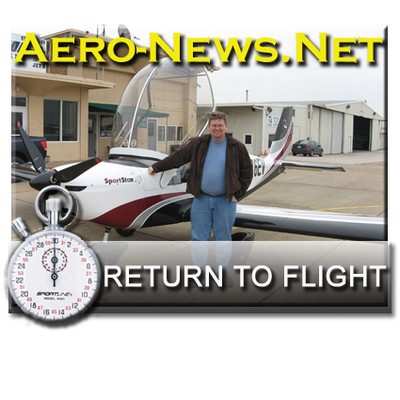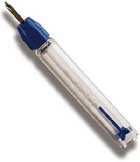Pattern Work, And Learning (Again) How To Land
by ANN Managing Editor Rob Finfrock
As I drove to my third flight lesson at Aviator Air in Grand
Prairie, TX earlier this month, I was expecting a call
cancelling the lesson at any minute. I'd checked the field AWOS
throughout the day. The wind was only blowing at around 12 knots
-- barely a breeze in Dallas, and more importantly, it was
blowing straight down the runway -- but the ceiling was only
1,100' AGL. Low clouds had enveloped the metroplex all day, with
nary an improvement.

Ah well, I thought. I'll stop in at the very least. There are
worst things to do than spend some time hanging around the airport
on a Friday afternoon.
A funny thing happened, though. By the time I pulled into the
parking lot, the ceiling miraculously lifted to over 2,000 feet --
more than enough for today's planned lesson in the pattern. Hey,
anyone can hang out at the airport... I was going to be able to fly
over it, after all!
 Jay watched as I preflighted the
plane. Evektor's preflight checklist is very thorough... but it
contains a few curious translations. The SportStar's Eastern
European origins are most apparent here; for example, "fuel
sumps" become "receivers of condensate."
Jay watched as I preflighted the
plane. Evektor's preflight checklist is very thorough... but it
contains a few curious translations. The SportStar's Eastern
European origins are most apparent here; for example, "fuel
sumps" become "receivers of condensate."
One thing I can't blame on the checklist, though, is my own
over-eagerness. So far, every time I've preflighted 676EV I've
skipped over a step. Nothing earth-shattering, mind you -- but it
does demonstrate that while I am using the checklist, my eyes are
also glazing over one part of it.
My white whale is the SportStar's pitot-static tube, tucked far
back under the plane's left wingtip (below). Maybe it's because I'm
used to high-wing aircraft, where the pitot tube is in plain
sight... but I tend to miss this vital part of the plane's
equipment when conducting what otherwise I would call a very
thorough preflight. I've caught my error every time... but I'm
still making the mistake.
Fortunately, it looks like it would take an act of God to harm
the SportStar's solid-chunk-of-metal pitot/static
tube. Judging by looks alone, it may just
be the single sturdiest component on the entire
plane.
With the preflight -- ALL of the preflight -- complete, Jay and
I climbed in the cockpit, ran through the required checklists
(that, perhaps in another odd translation, has the pilot checking
engine instruments three times within about 20 seconds... then
again, you can't check those things enough) and started up the
eager little Rotax.

By the time we'd taxied to the end of runway 35, the wind
had shifted just a bit from the west... and I could feel it as
we rolled into position. It is very important to hold proper
crosswind corrections in the SportStar; when I eased my aileron
correction slightly, and could feel the opposite wingtip lighten up
a bit. Nothing spooky, mind you... but the wind made the plane feel
light on its wheels.
Which was fine with me; the SportStar's made to fly, anyway, not
dally on the ground. The wind resulted in a short takeoff
roll; we weren't even 500 feet down GPM's 4,000 foot runway before
we were off. The plane duitfully settled into a slight crab to the
left; the winds were a bit stronger up here, than they were
off the ground.
As we entered right traffic, Jay repeated the steps we had
run through during our preflight briefing. "Level off at 1,500
feet." Check. "Bring throttle back to 4,200 RPM." Check. "That
should give us about 85 knots." Check.
Just seconds later, we were abeam the numbers, and ready to
descend. GPM's runway is over 2,000 feet shorter than
every other airport I've ever flown from... and I could
see the difference those 2,000 feet make! I had barely
processed "4,200 RPM" when it was time to bring out carb heat, and
slow to the white arc.
"Keep the nose up," Jay instructed. "Remember, don't descend
just yet."

Once we slowed to 80 knots, it was time for the first notch of
flaps. A Johnson bar between the seats controls the flaps on
SportStars, and it operates much the same way as a car's handbrake
does. Push the button in, and pull the lever up to deploy
the flaps.
Just as we had settled into a 500 feet-per-minute descent, it
was time to turn base leg. (Boy, things were happening fast!
I've done this before, right?) I put in the second notch of
flaps, for 30 degrees, as we turned onto base.
I turned to final just a bit too soon, and had to correct
slightly. There was very little crosswind, though, and I had
the plane lined up straight and true. What had felt like a
Keystone Kops-like routine to start, had settled down nicely.
We crossed the threshold at 60 knots, with power to idle. I
leveled off over the runway, and began the flare.
I realized a bit late my transition from descent, to level off,
to the flare had been one too-quick movement. In
response, the SportStar arrived on the runway with an uncomfortable
thud, on all three wheels.
OK... that didn't work.
Flaps back to takeoff position, carb heat in, advance the
throttle... and we were in the air again.
"Next time, ease into the flare," Jay instructed as we turned
crosswind. "Don't be quite so abrupt; let the plane settle
onto the runway."
Roger that. Soon we were abeam the numbers again. Time for
another try. Carb heat, slow to white arc, first notch of flaps.
Remember to report base leg to the tower. Add second notch of
flaps, keep the speed steady.
I turned onto final, this time better aligned with the runway.
The plane wanted to crab a bit -- the crosswind had become a but
more pronounced, but it was entirely manageable.
Over the threshold at 60, level off, flare... and darn
it, same result. The SportStar touched the pavement on all
three wheels, not as firmly as before but still lacking
finesse.
Argh!

In mild disgust I raised flaps to takeoff position, and shoved
the carb heat (above) in. This is a somewhat awkward
maneuver in the SportStar, due to the control's placement on
the far left side of the IP. To engage or disengage carb
heat, the pilot to either a) remove their left hand from the
stick to push the lever in, or b) take their right hand off the
throttle, and cross that hand over to push the lever closed.
My thoughts were still on my clumsy landing, though... and
not necessarily on the task at hand. As a result, as I applied full
throttle for takeoff, the SportStar veered left -- and continued in
that direction, despite what I thought were my best efforts to
counteract with right rudder. Fortunately, our speed was
sufficient... so I raised the nose and took off.
"That was... interesting," I said, after we were established in
the climb. At least I was able to keep the plane over the runway, I
noted.
Jay laughed a little. "You need to apply right rudder. You were
hard on the left that whole time."
Great, I thought to myself. Somehow I've been able
to forget nearly all my training from the past three years,
and turn into a complete and total dunderhead. And hey! I'm gonna
get to write about it, too, sharing my experiences with the entire
ANN readership!
I briefly wondered if it was too late to go back to wallboard
sales.
"My airplane," Jay told me. I gratefully relinquished the
controls. "Let me show you what I think you're doing wrong in the
flare." (Hint -- when your instructor uses this phrase, it
means they KNOW what you're doing wrong.)
Jay flew the pattern, and brought us over the numbers right at
60. His landing was as smooth as glass, and the plane stuck like
glue on the centerline as he cleaned up the plane and took off
again.
"Ease into the flare a bit more smoothly," Jay repeated. "Let
the plane settle onto the runway. Keep the nose up as long as you
can, but if you're too high, lower the nose a bit to smooth out the
landing."
"Oh, and let the plane roll out and settle before transitioning
for takeoff," Jay added. "We have plenty of runway available. Don't
try to do everything at once."
Ding!

I heard all of Jay's words, but his last admonishment
finally illuminated the proverbial lightbulb over my head. I was
treating the flare as one maneuver... instead of the series of
smaller ones that it is.
"Ready to try again?"
"Yep. I have the airplane," I replied.
"You have the airplane."
Apart from overshooting pattern altitude by 50 feet while
turning onto downwind, I flew the rest of that circuit to checkride
standards. As we crossed over the numbers, I reminded myself one
last time... "don't try to do it all at once."
Level off... stick neutral... nose up slightly... level
off... nose up again... a little more... a little more...
touchdown! Keep the nosewheel off... keep it off... keep it
off (as the SportStar doesn't have a stall warning horn, I
imagined one wailing in the background)... keep it off... and
down!
I'm also proud to note I kept the plane centered this time,
and I was able to transition for takeoff without sending us towards
the weeds. We lifted off smoothly... and this time, I felt like a
pilot. Again.
"Was that what you had in mind?" I asked Jay, grinning. He
nodded enthusiastically.
I flew four more circuits. Some were better than others... but
all were better than the first few had been.

"Good flight," Jay told me after shutdown.
"Yeah," I agreed. "But I can do a lot better, too."
Coming Next Week: Emergency Procedures... And When
You Shouldn't Fly
 ANN's Daily Aero-Linx (04.16.24)
ANN's Daily Aero-Linx (04.16.24) Aero-News: Quote of the Day (04.16.24)
Aero-News: Quote of the Day (04.16.24) Airborne 04.10.24: SnF24!, A50 Heritage Reveal, HeliCycle!, Montaer MC-01
Airborne 04.10.24: SnF24!, A50 Heritage Reveal, HeliCycle!, Montaer MC-01 Airborne 04.12.24: SnF24!, G100UL Is Here, Holy Micro, Plane Tags
Airborne 04.12.24: SnF24!, G100UL Is Here, Holy Micro, Plane Tags Airborne-Flight Training 04.17.24: Feds Need Controllers, Spirit Delay, Redbird
Airborne-Flight Training 04.17.24: Feds Need Controllers, Spirit Delay, Redbird









